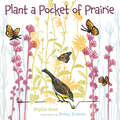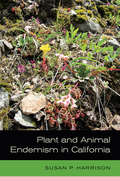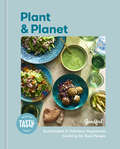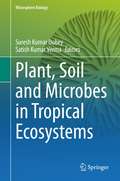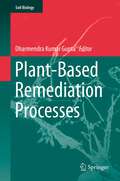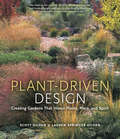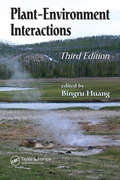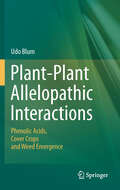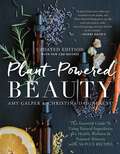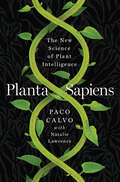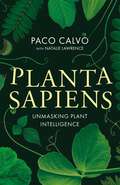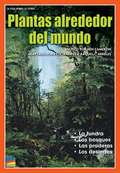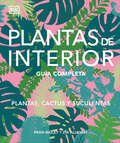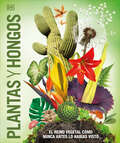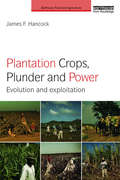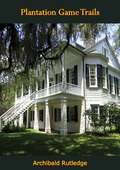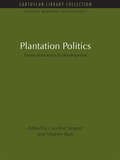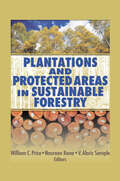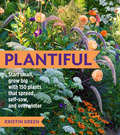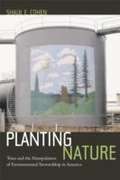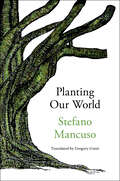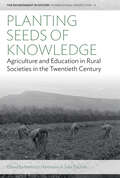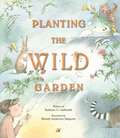- Table View
- List View
Plant a Pocket of Prairie
by Phyllis RootAuthor Phyllis Root and illustrator Betsy Bowen last explored the vast, boggy peatlands of northern Minnesota in their book Big Belching Bog. Now, in Plant a Pocket of Prairie, Root and Bowen take young readers on a trip to another of Minnesota&’s important ecosystems: the prairie. Once covering almost 40 percent of the United States, native prairie is today one of the most endangered ecosystems in the world. Plant a Pocket of Prairie teaches children how changes in one part of the system affect every other part: when prairie plants are destroyed, the animals who eat those plants and live on or around them are harmed as well. Root shows what happens when we work to restore the prairies, encouraging readers to &“plant a pocket of prairie&” in their own backyards. By growing native prairie plants, children can help re-create food and habitat for the many birds, butterflies, and other animals that depend on them. &“Plant cup plants,&” Root suggests. &“A thirsty chickadee might come to drink from a tiny leaf pool. Plant goldenrod. A Great Plains toad might flick its tongue at goldenrod soldier beetles.&” An easy explanation of the history of the prairie, its endangered status, and how to go about growing prairie plants follows, as well as brief descriptions of all the plants and animals mentioned in the story. With Betsy Bowen&’s beautiful, airy illustrations capturing the feel of an open prairie and all its inhabitants, readers of all ages will be inspired to start planting seeds and watching for the many fascinating animals their plants attract. What a marvelous transformation could take place if we all planted a pocket of prairie!
Plant and Animal Endemism in California
by Susan P. HarrisonCalifornia is globally renowned for its biological diversity, including its wealth of unique, or endemic, species. Many reasons have been cited to explain this abundance: the complex geology and topography of its landscape, the special powers of its Mediterranean-type climate, and the historic and modern barriers to the wider dispersal of its flora and fauna. Plant and Animal Endemism in California compiles and synthesizes a wealth of data on this singular subject, providing new and updated lists of native species, comparing patterns and causes of both plant and animal endemism, and interrogating the classic explanations proposed for the state's special significance in light of new molecular evidence. Susan Harrison also offers a summary of the innovative tools that have been developed and used in California to conserve and protect this stunning and imperiled diversity.
Plant and Animal Relationships: Investigation Notebook
by The Lawrence Hall of ScienceNIMAC-sourced textbook
Plant and Planet: Sustainable and Delicious Vegetarian Cooking for Real People
by GoodfulSimple steps can make an impact on our planet. From BuzzFeed&’s Goodful, these 75 plant-based recipes plus plenty of low-waste strategies will guide you to a sustainable life you can feel good about.Goodful offers approachable recipes, tips, and guides for everyday life. In Plant and Planet, discover seventy-five plant-based recipes for meal prep, everyday celebrations, and cooking with the seasons, from Zucchini Lasagna Boats and Black Bean & Walnut Quesadillas to Caramelized Banana & Orange Parfaits, along with tons of ways to stock your kitchen, grow your own ingredients, turn your scraps into amazing treats, and more. Beautifully photographed, this cookbook is super practical and impactful, with surprising and easy ways to reduce environmental impact, shopping guides and meal plans, information about repurposing food waste, plus a guide to growing your own ingredients. You will learn how to:• Approach cooking from a seasonal perspective• Minimize packaging while maximizing flavor• Clear out your fridge and freezer to make comforting soups, salads, and other dishesFeaturing contributions from experts DeVonn Francis, Lorena Ramirez, Lauren Singer, Nadiya Hussain, Kelis Rogers, David Zilber, and Ben Flanner, Plant and Planet is filled with tips and quick hits of information about the environmental impact of these recipes--all to deliver a low-stress, high-impact path to a low-waste kitchen.
Plant, Soil and Microbes in Tropical Ecosystems (Rhizosphere Biology)
by Satish Kumar Verma Suresh Kumar DubeyThis book describes the multitude of interactions between plant, soil, and micro-organisms. It emphasizes on how growth and development in plants, starting from seed germination, is heavily influenced by the soil type. It describes the interactions established by plants with soil and inhabitant microbial community. The chapters describe how plants selectively promote certain microorganisms in the rhizospheric ecozone to derive multifarious benefits such as nutrient acquisition and protection from diseases. The diversity of these rhizospheric microbes and their interactions with plants largely depend on plant genotype, soils attributes, and several abiotic and biotic factors. Most of the studies concerned with plant–microbe interaction are focused on temperate regions, even though the tropical ecosystems are more diverse and need more attention. Therefore, it is crucial to understand how soil type and climatic conditions influence the plant–soil–microbes interaction in the tropics. Considering the significance of the subject, the present volume is designed to cover the most relevant aspects of rhizospheric microbial interactions in tropical ecosystems. Chapters include aspects related to the diversity of rhizospheric microbes, as well as modern tools and techniques to assess the rhizospheric microbiomes and their functional roles. The book also covers applications of rhizospheric microbes and evaluation of prospects improving agricultural practice and productivity through the use of microbiome technologies. This book will be extremely interesting to microbiologists, plant biologists, and ecologists.
Plant-Based Remediation Processes
by Dharmendra Kumar GuptaPhytoremediation is an emerging technology that employs higher plants for the clean-up of contaminated environments. Basic and applied research have unequivocally demonstrated that selected plant species possess the genetic potential to accumulate, degrade, metabolize and immobilize a wide range of contaminants. The main focus of this volume is on the recent advances of technologies using green plants for remediation of various metals and metalloids. Topics include biomonitoring of heavy metal pollution, amendments of higher uptake of toxic metals, transport of heavy metals in plants, and toxicity mechanisms. Further chapters discuss agro-technological methods for minimizing pollution while improving soil quality, transgenic approaches to heavy metal remediation and present protocols for metal remediation via in vitro root cultures.
Plant-Driven Design: Creating Gardens That Honor Plants, Place, and Spirit
by Scott Ogden Lauren Springer OgdenFor too long, garden design has given pride of place to architecture, artifice, and arbitrary principles. The results? Soulless landscapes where plants play subordinate roles.With passion and eloquence, Scott Ogden and Lauren Springer Ogden argue that only when plants are given the respect they deserve does a garden become emotionally resonant. Plant-Driven Design shows designers how to work more confidently with plants, and gives gardeners more confidence to design. The Ogdens boldly challenge design orthodoxy and current trends by examining how to marry plantsmanship and design without sacrificing one to the other.Supported by extensive lists of plants adapted to specific purposes and sites, Plant-Driven Design explores how plants interact with place. In addition, the authors' experience gardening and designing in a wide variety of climates gives their perspective a unique depth. In ideas, scope, and detail, this book both embraces and transcends regionality. By reclaiming gardens as a home to plants, this groundbreaking work will restore life-affirming vitality to garden design and profoundly affect how we understand and experience gardens.
Plant-Environment Interactions
by Bingru HuangWith contributions from experts in various specialties, Plant-Environment Interactions discusses recent advances in cellular and molecular regulation of stress tolerance. This third edition reviews new research in stress signal perception, cellular mechanisms, and genetic manipulation of stress tolerance for each individual stress. It addresses how to evaluate the level of plant tolerance to stress as well as how to link mechanisms identified through analysis of plant-environment interaction to producing stress-tolerant germplasm through biotechnology and traditional breeding. It also examines environmental stresses limiting plant productivity in agriculture, horticulture, and forestry.
Plant-Plant Allelopathic Interactions: Phenolic Acids, Cover Crops and Weed Emergence
by Udo BlumIn an effort to implement conservation measures farmers have used a variety of production methods, including the use of reduced or zero tillage and cover crops. One benefit of these production methods has been early season weed control. The literature suggests that a variety of mechanisms may be involved, among them the allelopathic effects of phenolic acids. This retrospective analysis addresses the following: How likely are phenolic acid concentrations and environmental conditions in wheat no-till cropping systems for the inhibition of annual broadleaf weed emergence? and Do phenolic acids have a dominant role or are they just one component of a larger promoter/modifier/inhibitor complex? The book covers allelopathic plant-plant interactions, laboratory and field experiments, and future research. It uses a journal format, provides justifications for procedures used, if-then hypotheses, and cons and pros so that readers can reach their own conclusions.
Plant-Powered Beauty, Updated Edition: The Essential Guide to Using Natural Ingredients for Health, Wellness, and Personal Skincare (with 50-plus Recipes)
by Amy Galper Christina DaigneaultYou know your diet should be rich in plants for optimal health. So shouldn't the products you apply to your skin, which are absorbed into your body, also be filled with plants? If you've ever looked at the back of your so-called "natural" facial moisturizer or body cream and seen a list of complicated additives you couldn't recognize or pronounce, then you know firsthand that mass-produced synthetic beauty products can be something of a mystery. With Plant-Powered Beauty: The Essential Guide to Using Natural Ingredients for Health, Wellness, and Personal Skincare (with 50-plus Recipes), harness the power of plant-based energy to maintain your natural beauty and let your skin glow like never before. Natural beauty experts Amy Galper and Christina Daigneault show readers how to deconstruct beauty labels, parse ingredients lists, make informed choices about the products they use—and, most important, better understand how their skin works. At the heart of Plant-Powered Beauty, you will find more than 50 easy-to-follow recipes to make your own plant-based skincare and beauty products, such as: Almond Milk Facial Cleanser Anti-aging Facial Scrub Blemish Gel Choc-o-Mint Lip Balm Coconut Whip Makeup Remover Vitamin-Rich Hair Health Serum Quick and Fresh Cucumber-Thyme Body Scrub Moisturizing Body Oil for Super-Dry Skin Natural Mouthwash Plus, in this updated edition of Plant-Powered Beauty, meet the hottest wellness and beauty ingredient: cannabidiol, a very unique molecule within the Cannabis sativa plant. Research shows that CBD has a remarkable effect on the skin, including supporting tissue repair, evening skin tone, and promoting a youthful glow. New CBD recipes—for men and women!—include a salve to reduce pain, bath soak to address inflammation, facial serum for balancing, roll-on for stress relief, body butter, and more. Plant-Powered Beauty unlocks sought-after wisdom for all aspects of plant-based personal skincare and celebrates the shift in beauty trends, bringing us back to natural beauty and reconnecting us with plants and healthy choices.
Planta Sapiens: The New Science of Plant Intelligence
by Paco Calvo“Weaves science and history into an absorbing exploration of the many ways that plants rise to the challenge of living.” —Merlin Sheldrake, author of Entangled Life An astonishing window into the inner world of plants, and the cutting-edge science in plant intelligence. Decades of research document plants’ impressive abilities: they communicate with each other, manipulate other species, and move in sophisticated ways. Lesser known, however, is that although plants may not have brains, their internal workings reveal a system not unlike the neuronal networks running through our own bodies. They can learn and remember, possessing an intelligence that allows them to behave in flexible, forward-looking, and goal-directed ways. In Planta Sapiens, Paco Calvo, a leading figure in the philosophy of plant signaling and behavior, offers an entirely new perspective on plants’ worlds, showing for the first time how we can use tools developed to study animal cognition in a quest to understand plant intelligence. Plants learn from experience: wild strawberries can be taught to link light intensity with nutrient levels in the soil, and flowers can time pollen production to pollinator visits. Plants have social intelligence, releasing chemicals from their roots and leaves to speak to and identify one another. They make decisions about where to invest their growth, judging risk based on the resources available. Their individual preferences vary, too—plants have personalities. Calvo also illuminates how plants inspire technological advancements, from robotics to AI. Most importantly, he demonstrates that plants are not objects: they have their own agency. If we recognize plants as actors alongside us in the climate crisis—rather than seeing them simply as resources for carbon capture and food production—plants may just be able to help us tackle our most urgent problems.
Planta Sapiens: Unmasking Plant Intelligence
by Paco Calvo Natalie LawrenceWhat is it like to be a plant?It's not a question we might think to contemplate, even though many of us live surrounded by plants. Science has long explored the wonderful ways in which plants communicate, behave and shape their environments: from chemical warfare to turning their predators to cannibalism. But they're usually just the backdrop to our frenetic animal lives.While plants may not have brains or move around as we do, cutting-edge science is revealing that they have astonishing inner worlds of an alternate kind to ours. They can plan ahead, learn, recognise their relatives, assess risks and make decisions. They can even be put to sleep. Innovative new tools might allow us to actually see them do these things - from electrophysiological recordings to MRI and PET scans. If you can look in the right way, a world full of drama unfurls.In PLANTA SAPIENS, Professor Paco Calvo offers a bold new perspective on plant biology and cognitive science. Using the latest scientific findings, Calvo challenges us to make an imaginative leap into a world that is so close and yet so alien - one that will expand our understanding of our own minds.From their rich subjective experiences to how they are inspiring novel ways of approaching the ecological crisis, PLANTA SAPIENS is a dazzling exploration of the lives of plants and a call to approach how we think about the natural world in a new, maverick way.
Plantas de interior (Houseplant)
by DKConvierte tu casa en un oasis de interior y descubre todos los secretos para mantener tus plantas sanas y fuertes.Las plantas forman parte de la decoración de la casa, sobre todo para todos aquellos que no tienen jardín. Crea tu propio terrario, maceta colgante con macramé o una corona de suculentas, y dale vida a tu hogar gracias a este maravilloso libro sobre plantas de interior. Con explicaciones sencillas e instrucciones paso a paso, este libro es perfecto tanto para expertos en jardinería, como para principiantes con curiosidad por los beneficios que las plantas pueden aportar a su casa. Descubre las mejores especies de plantas de interior: resistentes, bonitas y fáciles de cuidar.En el interior de esta completa guía de jardinería encontrarás:-Más de 330 especies de plantas de interior, desde suculentas y cactus hasta orquídeas, bromelias e incluso plantas carnívoras.-Explicaciones sencillas sobre todos los cuidados esenciales para las plantas: riego, poda, trasplante, propagación, abono, enfermedades y plagas…-24 proyectos originales con instrucciones paso a paso.-Consejos sobre cómo decorar tu casa siguiendo un diseño de interior apoyado por los diferentes colores, texturas y formas de las diferentes plantas.Con instrucciones para ßque tus plantas crezcan sanas y fuertes, consejos para propagar plantas a través de esquejes y ampliar tu colección y 24 proyectos paso a paso diseñados para aprovechar al máximo la vegetación de tu hogar, Plantas de interior tiene todo lo que necesitas para crear, plantar y cuidar tu jardín de interior.Discover over 330 houseplant varieties and make the most of them with care advice, design inspiration, and step-by-step projects.Turn your living space into an indoor oasis with the RHS’s definitive guide to more than 330 houseplant varieties.Take your house plant collection to the next level with Houseplant. Discover the best varieties to suit your home from more than 330 profiles on every kind of houseplant you can imagine, from succulents and cacti to orchids, bromeliads, and even carnivorous plants.Complete with essential care advice to keep your plants alive and thriving, propagation tips to help you grow your collection, and 24 step-by-step projects designed to make the most of your greenery, Houseplant has everything you need to create, cultivate, and care for your indoor garden.
Plantas y hongos (Knowledge Encyclopedia Plants and Fungi!)
by DKExplora el maravilloso mundo de las plantas y los hongos, desde los cactus y las plantas carnívoras hasta los árboles, las flores y los hongos.¿Por qué las flores son coloridas y las frutas son dulces? ¿Cómo captura una planta carnívora a su presa? ¿Por qué pican las ortigas? ¿Cómo convierten los árboles la luz en alimento? Este libro sobre la naturaleza para niños fascinará a los lectores más jóvenes con detalles microscópicos y datos curiosos sobre el reino de las plantas y los hongos.En su interior, encontrarás: Datos, gráficos, líneas temporales e ilustraciones de una amplia gama de temas.Un enfoque visual único de las plantas y los hongos de todo el mundo, gracias a sus impresionantes y detalladas imágenes en 3D.Información valiosa que sirve de apoyo para los estudiantes de ciencias.¡La vida en la Tierra no podría existir sin plantas y hongos! Crean los alimentos que comemos y el oxígeno que respiramos, regulan el clima, proporcionan hábitats para los animales y producen recursos sostenibles que podemos usar para hacer libros, ropa, muebles y casas. Plantas y hongos muestra cómo estos seres vivos son los cimientos de todos los ecosistemas y hacen de nuestro planeta un lugar habitable. ¿A qué esperas para aprenderlo todo sobre los organismos imprescindibles para la vida en la Tierra?Explore the wonderful world of plants and fungi, with everything from cacti and carnivorous plants to trees, flowers, and mushrooms.Why are flowers colorful and fruits sweet? How does a carnivorous plant kill its prey? Why do stinging nettles sting? How do trees turn light into food? This ultimate nature book for children will fascinate young readers with its microscopic detail and amazing facts on the plant world. This all-encompassing nature encyclopedia for kids offers: A whole collection of facts, charts, timelines, and illustrations that cover a vast range of topics.Plants and fungi from around the world shown using amazingly detailed CGIs that entice young readers to dive in and explore.Important STEM topics covered in life sciences curricula.A visual approach using illustrations, photographs and extremely detailed 3D CGI images.Knowledge Encyclopedia: Plants and Fungi! shows how plants and fungi form the foundations of every ecosystem, making our planet habitable. Life on Earth couldn’t exist without plants and fungi. Plants create the food we eat and the oxygen we breathe. They regulate the climate, provide habitats for animals, and produce sustainable resources that we can use to make books, clothes, furniture and houses. Fungi are just as important.
Plantation Crops, Plunder and Power: Evolution and exploitation (Earthscan Food and Agriculture)
by James F. HancockOver the last five centuries, plantation crops have represented the best and worst of industrialized agriculture – "best" through their agronomic productivity and global commercial success, and "worst" as examples of exploitative colonialism, conflict and ill-treatment of workers. This book traces the social, political and evolutionary history of seven major plantation crops – sugarcane, banana, cotton, tea, tobacco, coffee and rubber. It describes how all of these were domesticated in antiquity and grown by small landowners for thousands of years before European traders and colonists sought to make a profit out of them. The author relates how their development and spread were closely associated with government expansionist policies. They stimulated the exploration of far off lands, were the focus of major conflicts and led to the enslavement of both native and displaced peoples. From the southern United States, Latin America and the Caribbean, to Asia and Africa, plantation crops turned social structures upside down leading to revolution and government change. The economies of whole countries became tied to the profits of these plantations, leading to internal power struggles to control the burgeoning wealth. Open warfare routinely broke out between the more powerful countries and factions for trade dominance. This book shows that from the early 1500s to today, at least one of the plantation crops was always at the center of world politics, and that this still continues today, for example with the development of oil palm plantations in Southeast Asia. Written in an accessible style, it is fascinating supplementary reading for students of agricultural, environmental and colonial history.
Plantation Game Trails
by Archibald Rutledge“TO have been able, during a matter of nearly thirty years, to follow the game trails of the great plantation region of the delta of the Santee—this has been my privilege. I have seen my homeland undergo great transformations during those years: the plantations have for the most part become waste tracts; many of the old families have died out; Nature has recaptured in her inimitable way what had been, for a few years, wrested from her. The game has held its own on these desolate plantations; and that is saying much in the modern day.“In these chapters I have tried to give a faithful account of the observations I have made as a hunter and as a lover of Nature. I have tried to present the wildwoods of the South as I have known them since boyhood. And I have attempted to preserve the memory of certain characters which have appeared to me worthy of a place in the picturesque gallery of American woodsmen.” (Preface)Richly illustrated throughout.
Plantation Politics: Forest plantations in development (Natural Resource Management Set)
by Stephen Bass Caroline SargentPlantations are playing an increasingly important part in the development and the economies of the South. Plantation Politics is the first book to examine their rationale and purpose, exposing the misconceptions and myths that have surrounded their role, and describing the contribution they can make to sustainable development. At their best, industrial plantations can become a major asset to local development by providing raw materials, infrastructure, employment, income and environmental and recreational services. At their worst, plantations, usually imposed from a 'top-down' perspective and ignoring local needs, values and rights, have monopolized land in times of food shortage, degraded wild animal and plant populations, and destroyed habitats and landscapes. The contributors analyse the conditions appropriate for both simple and complex plantations, and the contributions each can make. Complex plantations, whether established from scratch or within natural forest, are more suitable in most cases, where they are subject to numerous different claims and needs. However, their ownership, management and silviculture present new challenges � challenges which, without the carefully researched guidelines offered here, current policy and research may well be ill-equipped to take up. Caroline Sargent is the Director and Stephen Bass is the Associate Director of the Forestry Programme at the International Institute for Environment and Development. Originally published in 1992
Plantation Worlds
by Maan BaruaIn Plantation Worlds, Maan Barua interrogates debates on planetary transformations through the histories and ecologies of plantations. Drawing on long-term research spanning fifteen years, Barua presents a unique ethnography attentive to the lives of both people and elephants amid tea plantations in the Indian state of Assam. In the nineteenth and early twentieth centuries, nearly three million people were brought in to Assam’s plantations to work under conditions of indenture. Plantations dramatically altered the region’s landscape, plundered resources, and created fraught worlds for elephants and people. Their extractive logics and colonial legacies prevail as durations, forging the ambit of infrastructures, labor, habitability, and conservation in the present. And yet, as the perspectives of the Adivasi plantation worker community and lifeworlds of elephants show, possibilities for enacting a decolonial imaginary of landscape remain present amid immiseration. From the margins of the Global South, Barua offers an alternative grammar for articulating environmental change. In so doing, he prompts a rethinking of multispecies ecologies and how they are structured by colonialism and race.
Plantations and Protected Areas in Sustainable Forestry
by V. Alaric Sample William C. Price Naureen RanaUnderstand the social, economic, and environmental impacts of the development of forest plantationsand the conservation involvedControversy surrounds the question of how to best protect forests of high conservation value, while meeting the growing demands for wood and wood fiber-based products. Plantations and Protected Areas in Sustainable Forestry presents the views of a diverse group of conservationists and natural resource professionals who examine important social and economic as well as ecological aspects of the debate. The goal of sustainable forest management is kept at the forefront of the discussions, while alternative strategies to meet economic and social needs are explored in light of the need to conserve biological diversity and protect other important ecological services and environmental values in key forest areas. For developed nations, there is an ethical responsibility to consider sensible development as well as environmental conservation. Plantations and Protected Areas in Sustainable Forestry discusses many of the prominent issues that are raised when considering intensively managed forests (plantations) and/or strict protection of high conservation value forests (protected areas) in the United States and elsewhere. These issues include: the role of plantations and their management; forest management certification to ensure sustainability; job creation from plantations, the effects of intensive forest management on society and the environment; and the protection of biodiversity. This book provides a solid foundation on which to form a consensus that addresses the needs of economics and society as well as forest conservation.Topics in Plantations and Protected Areas in Sustainable Forestry include: the future of forest plantations forest management certification community benefits derived from intensively managed industrial roundwood plantations the extent to which intensive forest management practices on plantations prevent degradation of natural forests positive and negative impacts of plantations on environmental and social values alternative approaches for investment in wood production global policy perspectives on intensive forest production global strategies for biodiversity conservation Plantations and Protected Areas in Sustainable Forestry provides a diversity of perspectives on one of today’s most important developments in international forest policy and international trade in the forest sector. It is intended to contribute to better-informed decision-making, and is an important book for policymakers, forest resource management professionals, and business leaders working to develop practical and effective strategies for sustainable forest management.
Plantiful: Start Small, Grow Big with 150 Plants That Spread, Self-Sow, and Overwinter
by Kristin Green“Thrifty gardeners take note: the bucks saved on plant purchases will pay back the purchase price of Plantiful with dividends.” —Tovah Martin, author of The Unexpected Houseplant Whoever coined the phrase “money doesn’t grow on trees” must not have been a resourceful gardener. Plantiful shows you how to have an easy, gorgeous garden packed with plants by simply making the right choices. Kristen Green highlights plants that help a garden quickly grow by self-sowing and spreading and teaches you how to expand the garden and extend the life of a plant by overwintering. The book features plant profiles for 50 self-sowers (including columbine, milkweed, and foxglove), 50 spreaders (such as clematis, snow poppy, and spearmint), and 50 plants that overwinter (including lemon verbena, begonia, and Chinese hibiscus). Additional gardening tips, design ideas, and inspirational photos will motivate and inspire gardeners of all levels.
Planting Nature: Trees and the Manipulation of Environmental Stewardship in America
by Shaul Ephraim CohenShaul E. Cohen exposes how big business, the government, and tree planting groups often work together to manipulate trees - and the people who plant them. He reveals how positive associations and symbols invested in trees are exploited by an interlocking network of government agencies, private timber companies, and nongovernmental organizations to subvert the power of people who think that they are building a better world. Cohen traces the roots of the story in the history of tree planting in the United States, the rise of popular sentiment around trees, the development of the Arbor Day holiday, and the growth of tree-planting groups such as the National Arbor Day Foundation and American Forests. Drawing from internal papers, government publications, advertisements, and archival documents, Cohen illustrates how organizations promote tree planting to deflect attention from the causes of environmental problems, masking business-as-usual agendas. Ultimately, Planting Nature challenges the relationships between a "green" public, the organizations that champion environmental causes, and the powers that be, providing a cautionary tale of cooperation and deception that cuts across the political spectrum.
Planting Our World
by Stefano MancusoWith fun, fascinating vignettes, a renowned neurobiologist illuminates the interconnectedness of plant life and how we can learn from it to better plan our communities.We animals account for a paltry 0.3% of the planet&’s biomass while plants add up to 85%. And when, with just a little training, we are able to look at the world without seeing it solely as humanity&’s playground, we cannot help but notice the ubiquity of plants. They are everywhere, and their stories are inevitably bound up with ours. As every tree in a forest is linked to all the others by an underground network of roots, uniting them to form a super organism, so plants constitute the nervous system, the plan that is the &“greenprint&” of our world. To ignore the existence of this plan is one of the most serious threats to the survival of our species. In this latest book, the brilliant Stefano Mancuso is back to illuminate the greenprint of our world. He does it through unforgettable stories starring plants that combine an inimitable narrative style with remarkable scientific rigor, from the story of the red spruce that gave Stradivarius the wood for his fourteen violins, to the Kauri tree stump, kept alive for decades by the interconnected root system of nearby trees. From the mystery of the slipperiness of the banana skin to the plant that solved the &“crime of the century,&” the Lindbergh kidnapping, by way of wooden ladder rungs.
Planting Seeds of Knowledge: Agriculture and Education in Rural Societies in the Twentieth Century (Environment in History: International Perspectives #24)
by Julia Tischler Heinrich HartmannIn the late nineteenth and early twentieth centuries, agricultural practices and rural livelihoods were challenged by changes such as commercialization, intensified global trade, and rapid urbanization. Planting Seeds of Knowledge studies the relationship between these agricultural changes and knowledge-making through a transnational lens. Spanning exchanges between different parts of Europe, North and South America, the Indian subcontinent, and Africa, the wide-reaching contributions to this volume reform current historiography to show how local experiences redefined global practice.
